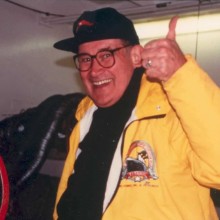By Lori Burke and Tiffany Bentley
Over the stern of the MS Balmoral on April 15, John Eaton ’48 watched as memorial wreaths bobbed on the ocean’s surface, miles above the wreck of the RMS Titanic. As the Balmoral’s orchestra played the hymn, Nearer, My God, to Thee, Eaton was startled by a realization.
“I was there at the magical moment when Titanic’s past suddenly became her future,” he remembers of the ceremony, which took place at the location and during the hours of the great ship’s sinking 100 years ago. “This piece of history that I spent so many years studying suddenly became something new—almost unknown. Something I was going to have to, in many respects, restart my consideration of.”

John Paul Eaton '48 boarding the submersible on the way to the Titanic wreck in 1993.
Eaton and his long-time coauthor Charles Haas were featured lecturers aboard the memorial cruise that followed Titanic’s route on the centennial anniversary of its fated maiden voyage. Calling the journey an “epic” culmination of decades of study, the respected historian enjoyed the trip through time surrounded by more than 1,300 passengers, often dressed in period garb, who shared his enthusiasm for Titanic.
“Charles and I were almost instant celebrities,” he says. “Two-thirds of our audiences were well-acquainted with Titanic. It was nice to be accepted as a member of a community that knows so much.”
Eaton, of Cold Spring, N.Y., is co-founder, historian, and longtime trustee of the Titanic International Society, a nonprofit that works to preserve and archive the ship’s history. His research, which has included interviews with many Titanic survivors and their families and an underwater voyage to the wreck site, has resulted in five books and numerous articles and presentations.
A biology graduate, Eaton pursued his avocation throughout his career in hospital administration. He first became interested in the Titanic when he saw a painting of the historic event in Esquire magazine in 1946.
A consummate storyteller, Eaton credits his keen perceptions and ability to interpret emotions to more than 35 years in a New York City emergency room. “[My appreciation of] the value of human life has helped me with the study of the Titanic,” he says.
Committed to knowing the lives of the victims, he memorializes them through story. He is particularly interested in celebrating those who became heroes that night.
“Most of the people involved in Titanic’s loss were not ordinarily brave men. The ship sank two hours and forty minutes after hitting the iceberg. Men who became heroes acted instinctively. They didn’t have time to give thought to their deeds. And, that makes [their actions] even more remarkable.”
While others may have considered the anniversary journey a closure, Eaton was reenergized. “It gave me a whole new perspective of Titanic’s future life. For example, what is the value—not only of material, but also intellectual property—associated with a 100-year-old wreck?” he asks rhetorically.
With future journeys to Titanic now under the jurisdiction of the United Nations Educational, Scientific, and Cultural Organization (UNESCO), Eaton says the ship will be “very carefully guarded and securely controlled.”
Eaton and Haas have penned five books. The third edition of Titanic: Triumph and Tragedy was released in December 2011. In addition, they authored Titanic: Destination Disaster; Titanic: A Journey Through Time; Titanic, The Exhibition; and Falling Star: Misadventures of White Star Line Ships.
Eaton served as historical consultant to expeditions to the wreck site in 1993, 1996, and 1998. He also contributed to the design of artifact exhibits for RMS Titanic Inc., and Maryland Science Center.

1 Comment
Jack – Ed Tobias and I were just talking about you and he found you! We were doing reminiscing about our wonderful days in the Roosevelt ER and you were a big part of it.
Now, to remind you of who I am – Kathy McDonald, the evening nurse in the ER in the 1960’s.
Let’s connect. Ed found what we think is your phone number and I’m going to try and reach you. My cell is 301-412-8775.
Fondly,
Kathy McDonald Corey
Comments are closed.